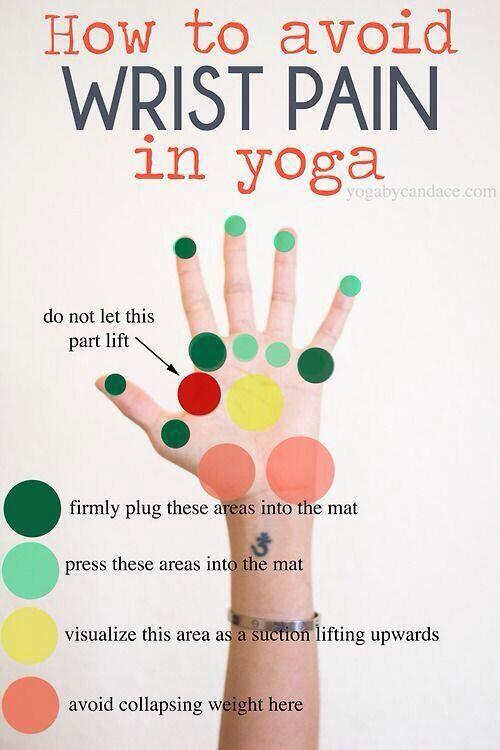How To Avoid Wrist Pain In Your Practice
We all want to stay injury-free; that is a given. From time to time, pains and aches may arise due to life circumstances or daily living patterns. In our present era, wrist issues do arise due to keyboarding etc and those can play in to your yoga practice. Here is a neat diagram to better help understand how your hand placement should to maximize the health of your wrist.

Next we have an article from MyYogaOnline that gives a more detailed explanation about the anatomy, movement, and dynamics of the wrist joint with regard to our yoga practice.
Avoiding Wrist Pain and Compression in Yoga
By Kreg Weiss, B HKin // Courtesy of myyogaonline.com
A recurring question I receive from yoga students is about issues with wrist discomfort and injuries. Having had a history of wrist injuries due to competitive sports, I am sensitive to how students work with their hands within poses and overall sequencing in the practices. Due to the nature of most hand positions in yoga poses, there is a tendency to collapse into specific areas of the wrist and—without due care—this can have detrimental effects.
A very common position for the hands in yoga poses is shoulder width apart: arm balances, Upward Facing Dog, Downward Facing Dog, Cat pose, etc. The consequence of this hand position is the ease to shift body weight into the hypothenar region of the hand (pinky finger side of the palm). Studies have been conducted measuring the force loads in the hands as hand position is varied. When the hands are set in a wide pushup stance, the force loads were found to be localized in the thenar region (thumb pad region). When the hands were brought in closer to a tricep pushup position (more classic hand position for yoga poses), the force loads shifted to the hypothenar region (pinky finger side of the hand/wrist).
When we look at the anatomy of the forearm and wrist, it is compelling to see that at the thenar region of the wrist, the radius (lateral forearm bone) broadens and has a large connection to the wrist bones. Unlike the radius, the ulna does not articulate with the carpal bones instead articulating with a cartilaginous disc known as the triangular fibrocartilage complex (TFCC), which lies between each. Without this complex, the radius would assume 95% of force loads. With this TFCC structure, the radius experiences about 80% of force loads where as the ulna experiences about 20%.
Knowing these structural elements of the wrist along with how force loads shift depending on hand placement, we need to be mindful that the hypothenar region of the hand is not necessarily an advantageous place to apply force. Therefore, we need to apply applications of force distribution to insure that we are dissipating the force over a greater surface area and out of the hypothenar region.
There are many ‘hand applications’ including the suggested ‘finger tip pressing’ and ‘palm doming’ that are worth exploring. From a more simplistic approach, I prefer to engage in subtle techniques of feeding energy out of the hypothenar area and…sending these force loads diagonally across to the index finger and index pad. Also key is the utilization of mild wrist pronation (internal rotation of the forearm) in many poses. Many loaded postures like Downward Facing Dog create a lifting motion of the index finger pad and direct enormous weight into the hypothenar region due to a tendency to supinate the wrist (external rotation). Note: with any pronation in the wrist/forearm, the kinetic chain of the entire arm and shoulder needs to be considered (how does the adjustment of the forearm affect the integrity further up the chain and do any counter adjustments higher up need to be applied?).
Other tips for nurturing the wrists in yoga:
- Sequence your practice so that you are not chronically loading the wrist with constant weight on the hands – design flows that provide discernible rest for the wrists.
- Consider occasionally doing practices that are completely free of placing weight on the wrists.
- If pushup/plank positions are a challenge, try these poses with wider hands – develop your strength in the more classic pushup position before attempting the yoga/tricep variations.
- Be extra mindful when practicing on carpet and thick yoga mats – thick, soft surfaces readily cause additional sinking and compression into the wrists.

Thanks for explaining how to avoid wrist pain. It can be so much disturbing to not being able to use your hands properly because of the wrist pain So it’s better to try and avoid it from starting in the first place.
Knowing these structural elements of the wrist along with how force loads shift depending on hand placement, we need to be mindful that the hypothenar region of the hand is not necessarily an advantageous place to apply force. Therefore, we need to apply applications of force distribution to insure that we are dissipating the force over a greater surface area and out of the hypothenar region.
Thanks